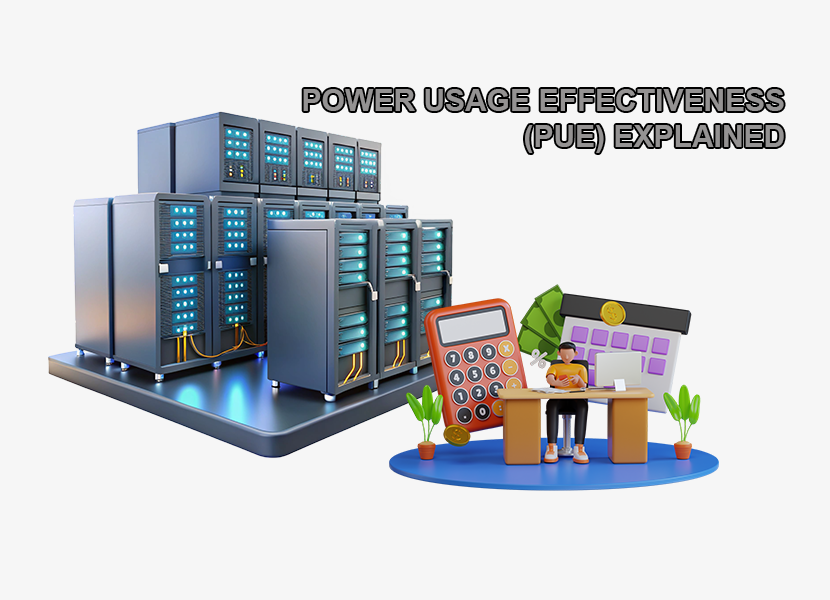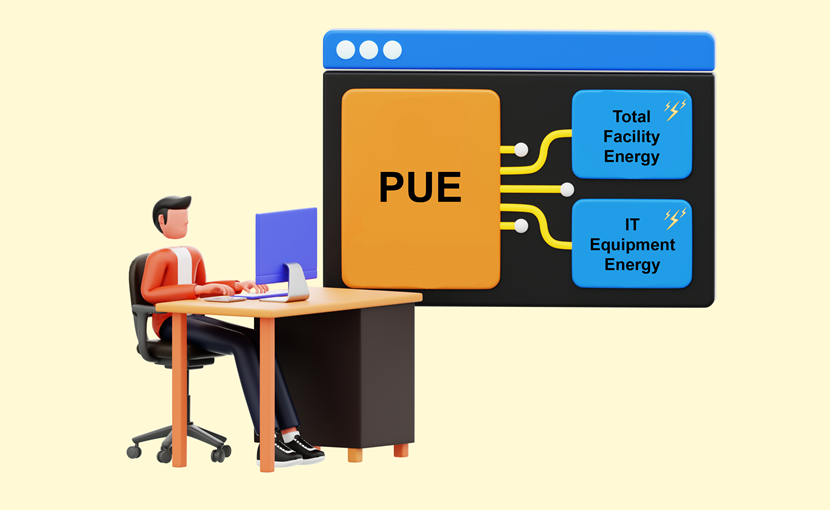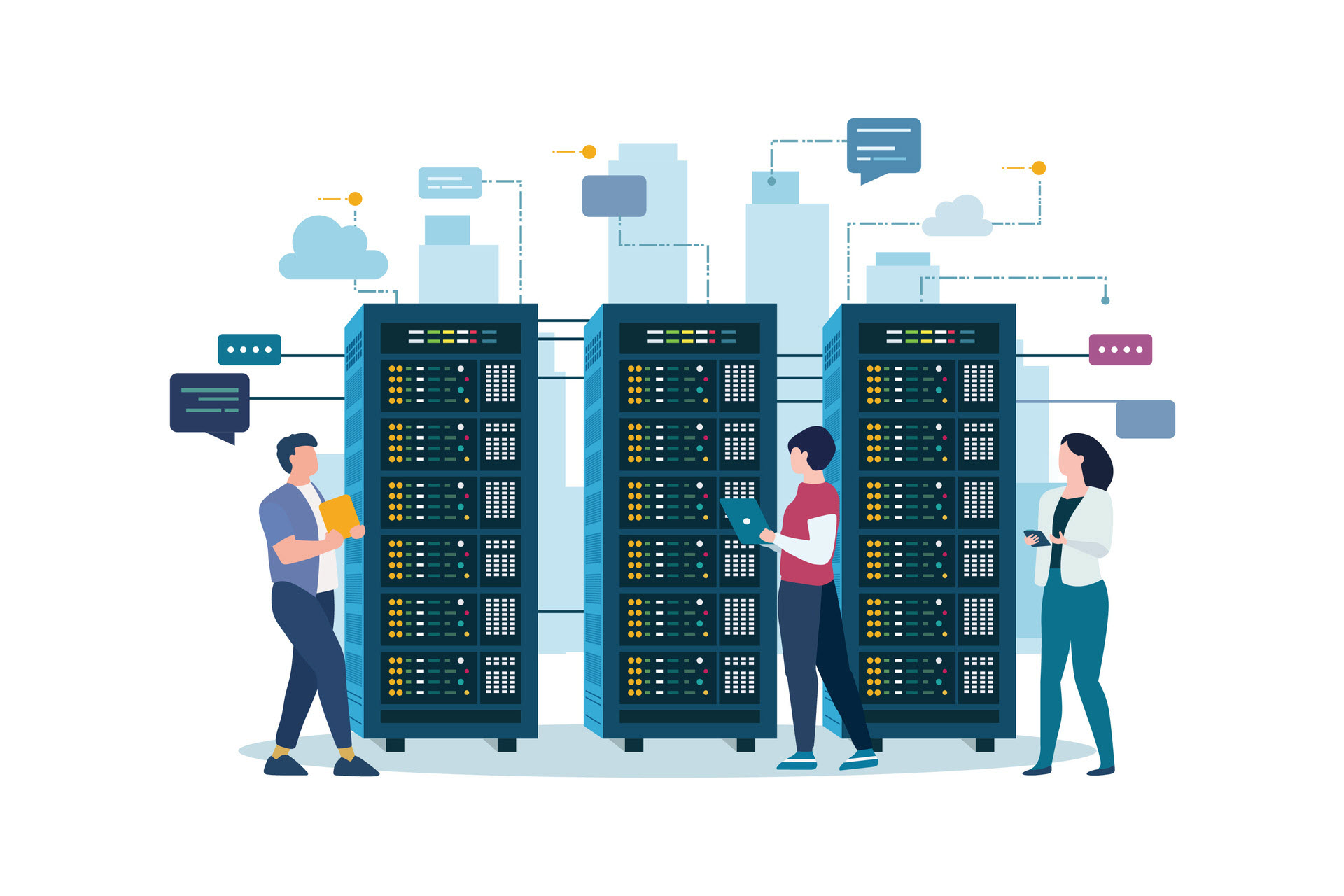Power usage effectiveness (PUE) is one of the most widely recognized metrics for assessing energy efficiency in data centers. By providing a simple yet powerful way to analyze power consumption, PUE enables facility operators to pinpoint inefficiencies, reduce waste, and develop strategies for leaner energy use.
This article provides an in-depth look at power usage effectiveness and its role in modern data center management. Read on to learn how to calculate PUE and use its insights to drive smarter, more sustainable energy strategies.

What Is Power Usage Effectiveness (PUE)?
Power usage effectiveness is a metric that measures the energy efficiency of a data center. PUE assesses how much of a facility's total power goes to computing versus overhead systems like cooling and lighting. PUE is expressed as a ratio. You can calculate it with the following formula:

Here's what both of these variables stand for:
- Total Facility Energy refers to all the energy consumed by the data center, including HVAC, lighting, power conversion, UPS systems, and IT hardware.
- IT Equipment Energy refers specifically to the power used by the computing equipment (servers, storage devices, network switches, etc.).
The higher the PUE, the more energy is being consumed by non-IT systems (cooling, lighting, power distribution, etc.). A PUE of 1.0 is ideal, as it indicates that 100% of the energy is used by IT equipment with zero overhead.
In practice, achieving a PUE of 1.0 is impossible. Energy-efficient data centers operate in the <1.5 PUE range, while older or less optimized facilities often have a PUE of 2.0 or higher.
PUE provides data center operators with a clear, actionable snapshot of energy use. The metric enables teams to benchmark performance over time, compare efficiency across multiple facilities, and pinpoint areas of excessive energy loss. That said, PUE is not without limitations. The metric does not account for energy reuse (e.g., waste heat recovery). Additionally, it assumes all IT energy is used productively, so idle or underutilized servers distort the metric. Despite these issues, PUE remains one of the most practical and widely accepted standards for monitoring and improving energy efficiency in data centers.
Data center power monitoring is crucial in PUE measurements because it provides real-time energy data necessary to evaluate the efficiency of both IT equipment and supporting infrastructure.
PUE vs. DCiE
PUE and data center infrastructure efficiency (DCiE) are related metrics used to evaluate data center energy efficiency. While they reflect the same underlying data, they express it in inverse ways and are used slightly differently depending on context. DCiE represents the percentage of total energy actually utilized by IT equipment. Here's how to calculate this metric:

An ideal DCiE value of 100 percent indicates that all energy is allocated to IT systems with no overhead. DCiE can be more intuitive for those who prefer percentage-based metrics and is often used in internal reports or executive summaries.
PUE and DCiE are mathematically inverse. A PUE of 2.0 equates to a DCiE of 50%; a PUE of 1.25 corresponds to a DCiE of 80%.
Both PUE and DCiE provide insight into the efficiency of a data center, but PUE is more commonly used and widely standardized across the industry. Ultimately, the choice between PUE and DCiE comes down to reporting needs and audience preferences.
Benefits of PUE
Measuring and making decisions based on power usage effectiveness is highly beneficial, especially for data centers with significant infrastructure. Here are the most notable advantages:
- Operational cost savings. By identifying inefficiencies (especially in cooling and power delivery), PUE allows data centers to make targeted changes that lower electricity usage. These optimizations can translate into significant cost reductions over time, particularly in larger facilities.
- Energy efficiency improvements. PUE helps organizations assess the portion of their total energy consumption that is dedicated to actual computing power. These insights enable facility managers to develop effective strategies for enhancing overall energy efficiency.
- Informed infrastructure investments. PUE supports smarter, data-driven decisions about where to allocate capital. Facilities can prioritize upgrades that deliver the greatest efficiency gains and return on investment (ROI).
- Repeatable power tracking. PUE is designed to be calculated regularly, which allows organizations to monitor changes in data center efficiency over time. This repeatability helps track the impact of improvements and operational changes.
- Environmental impact reduction. Organizations focused on sustainability can use PUE as a measurable benchmark to track and report their progress toward environmental goals, such as reducing their carbon footprint or achieving net-zero targets.
- Regulatory and certification alignment. Many energy-related certifications and regulations require the use of standardized efficiency metrics. Tracking and reporting PUE helps organizations qualify for green certifications such as LEED or ENERGY STAR, as well as demonstrate compliance with national or regional energy mandates.
Tracking PUE is central to data center sustainability efforts as the metric provides a quantifiable baseline for measuring the impact of energy-saving initiatives over time.
How to Calculate PUE
Power usage effectiveness is a simple ratio for measuring how efficiently a data center uses energy. It compares the total energy consumed by the entire facility to the energy used by the IT equipment alone. Here's a step-by-step calculation:
- Measure total facility energy. Use power meters or monitoring tools to measure the total electrical energy consumed by the entire data center over a specific period (a day, a week, or a month). This number includes all overhead energy (cooling, lighting, power conversion, etc.).
- Measure IT equipment energy. Measure only the power consumed by the IT equipment using dedicated meters or monitoring tools connected to the server racks or IT power distribution units (PDUs).
- Calculate the PUE ratio. Divide the total facility energy by the IT equipment energy to get the PUE.

The three examples below illustrate how different levels of energy consumption in data centers affect the PUE value and what that means for overall efficiency.
Example 1: Basic Calculation
- Total Facility Energy = 1,000 kWh
- IT Equipment Energy = 600 kWh
PUE = 1000/600 = 1.67
For every 1 watt the IT equipment uses, the facility uses 1.67 watts total, so 0.67 watts for cooling, lighting, and other overhead.
Example 2: Poor Efficiency Scenario
- Total Facility Energy = 1,400 kWh
- IT Equipment Energy = 600 kWh
PUE = 1400/600 = 2.33
This data center consumes significantly more overhead energy than the previous example, indicating substantial opportunities for improvement in cooling, power distribution, and other infrastructure.
Example 3: Improved Efficiency Scenario
- Total Facility Energy = 800 kWh
- IT Equipment Energy = 600 kWh
PUE = 800/600 = 1.33
This data center uses less overhead energy (0.33 watts per watt of IT load), which shows improved efficiency compared to Examples 1 and 2.
What Is Ideal PUE?
The ideal power usage effectiveness value is 1.0, which represents a perfectly efficient data center where all the energy consumed is used exclusively by servers, storage, and networking hardware. A PUE of 1.0 means the facility is spending no overhead energy on cooling, power conversion, lighting, or other infrastructure.
Achieving a PUE of exactly 1.0 is theoretically the best-case scenario, but in practical terms, it is virtually unattainable because data centers require supporting systems to maintain optimal operating conditions for IT hardware.
In the real world, highly optimized data centers have PUE values in the range of 1.1 to 1.4. This PUE value means that for every watt the IT equipment uses, an additional 0.1 to 0.4 watts are consumed by the supporting infrastructure.
On the other hand, data centers with PUE values above 2.0 are often considered inefficient, as more than half of the total power is used by non-IT systems. Such high values suggest that there are substantial opportunities to make improvements, such as:
- Upgrading cooling systems to use more efficient technologies and better airflow management.
- Optimizing operational practices by eliminating idle equipment and streamlining maintenance.
- Improving power management through more efficient UPS systems and real-time monitoring.
- Enhancing IT equipment efficiency with virtualization, hardware upgrades, and power-saving settings.
- Integrating renewable energy sources like solar or wind to offset grid reliance.
- Redesigning the facility layout to reduce thermal loss and improve airflow.
PUE is a relative metric. Its interpretation depends on factors such as geographic location, climate, and the size of the data center. For example, a data center in a warmer climate may have inherently higher cooling needs, which could result in a higher baseline PUE.
Likewise, very small or specialized facilities might not achieve the same efficiency gains as large-scale hyperscale data centers.
The Importance of Reducing PUE
Reducing power usage effectiveness is a critical goal for data centers aiming to improve operational efficiency, lower ongoing costs, and minimize environmental impact.
A lower PUE indicates that IT equipment directly uses a greater proportion of a facility's energy. This efficiency translates into significant financial savings, particularly for large-scale operations where even small improvements in PUE yield substantial reductions in electricity bills.
Beyond cost savings, a lower PUE also contributes to sustainability objectives. Energy-efficient data centers consume less power overall, which reduces their carbon footprint and supports broader corporate environmental goals like achieving net-zero emissions or qualifying for green certifications. Finally, reducing PUE enhances competitive positioning. Organizations with highly efficient data centers can market their sustainability and cost-effectiveness to appeal to environmentally conscious customers. Low PUE also helps demonstrate operational excellence to stakeholders.
How to Lower PUE
Lowering PUE requires a combination of strategic planning, smart infrastructure choices, and ongoing operational improvements. Here are some of the most effective ways to reduce overhead energy use and improve overall efficiency:
- Virtualization and server consolidation. By consolidating workloads and virtualizing servers, organizations can reduce the number of required physical machines. Fewer servers result in less heat and power consumption, which in turn improves the PUE ratio.
- Cooling system optimization. Improving airflow management through techniques like hot/cold aisle containment, blanking panels, and raised floors reduces the energy needed for cooling. More advanced methods, such as liquid cooling or economizers (free cooling), further improve thermal efficiency and lower overall facility power use.
- Power distribution efficiency. Upgrading power delivery infrastructure (e.g., using high-efficiency UPS or minimizing power conversion steps) can reduce losses between the utility feed and the IT equipment.
- Lighting efficiency upgrades. Replacing traditional lighting with motion-activated LED systems can significantly reduce non-IT power consumption, especially in large facilities.
- Real-time monitoring and analytics. Using DCIM tools to monitor power usage across systems provides better visibility into inefficiencies. Continuous data analysis supports proactive energy management and faster identification of abnormal consumption patterns.
- Regular maintenance and equipment upgrades. Routine inspection and timely replacement of aging power supplies and HVAC systems ensure that the infrastructure continues operating at optimal efficiency.
- Facility layout and airflow design. Strategically arranging server racks and using airflow modeling enables better heat dissipation and helps avoid hotspots. This practice reduces reliance on excessive cooling, which enables a more balanced and efficient facility design.
Incorporating PUE metrics into data center capacity planning helps organizations forecast energy needs and improve overall power efficiency.
PUE Challenges
While PUE is a valuable metric for improving data center efficiency, there are several challenges that limit its accuracy, effectiveness, and ease of implementation. Below are the most common obstacles organizations face when working with PUE:
- Measurement accuracy. Accurately capturing both total facility energy and IT equipment energy requires a well-placed metering infrastructure. Incomplete or inconsistent data collection often leads to misleading PUE readings.
- Legacy infrastructure limitations. Older data centers often lack the hardware and architectural flexibility to implement modern energy-saving techniques. Upgrading outdated cooling systems, power distribution, or server hardware is often too costly and operationally disruptive to be worth the effort.
- External environmental factors. Different data center sites can heavily influence the facility's cooling needs. Data centers in hot or humid environments often have inherently higher PUEs, which makes it difficult to compare efficiency fairly across different regions.
- Inconsistent reporting standards. Without standardized methods for measuring and reporting PUE, comparisons between organizations or different data centers within the same company can be unreliable. Variations in measurement intervals, equipment inclusion, or data granularity often skew results.
- Overemphasis on a single metric. Focusing solely on PUE may obscure other important performance indicators, such as computing performance per watt or workload efficiency. A narrow view on PUE also leads to decisions that improve the ratio without necessarily enhancing real-world performance.
- Temporary or seasonal fluctuations. PUE values vary significantly based on seasonal temperature changes, workload spikes, and maintenance events. A single measurement may not accurately represent long-term efficiency, which makes trend analysis and context essential.
Check out our article on server rack sizes to better understand the relationship between rack layout, equipment density, and power efficiency.
Use PUE to Create High-Performance, Energy-Conscious Infrastructure
By understanding energy consumption and identifying areas of loss, data center operators can make informed decisions that promote cost reduction and sustainability. Whether you are benchmarking a new facility or optimizing an existing one, the insights from this article can assist you in accurately assessing and improving your energy consumption strategy.



